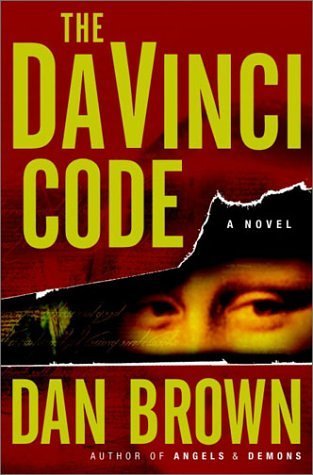The latest art history mystery by Dan Brown is a fast-paced book that is hard to put down. With deliciously short chapters that usually end in cliff-hangers, The Da Vinci Code is an exciting summer read with serious undertones. An intelligent spin that challenges the typical interpretation of Western history, the novel draws upon historical backing to suggest radical theories on art, politics, and religion – all set in a Bond-like context throughout the streets of Paris. Unfolding dark secrets in a modern-day setting, The Da Vinci Code appeals to Harry Potter fans as well as history buffs due to its smart blend of myth and reality.
The protagonist, Robert Langdon, is a symbology professor at Harvard (we’ll excuse him in this case…) who is visiting Paris to give a lecture and meet with the head curator of the Louvre, Jacques Saunière. However, Langdon’s plans to meet the famous curator are spoiled when his body is discovered on the floor of the Grand Hall of the museum. Strangely enough, Saunière’s body, naked and spread-eagled, resembles…Leonardo da Vinci’s Vitruvian Man! Before the puzzled professor can make sense of the scene, agent Sophie Neveu, a French police cryptologist, enters the room to decipher the riddle. It turns out that she is the deceased curator’s granddaughter, and her quest is to decipher what her grandfather was really trying to explain from the grave. And that’s only the first chapter… From that point, the book takes off at a startling pace, with each brief chapter ending in suspense as the two characters try to make sense of the clues Saunière left behind. You’ll fly through the pages as the main characters rampage the streets of Paris in search of the truth.
Brown’s writing has a cinematic feel, due to the sharp plot twists and short chapters. You can imagine the book becoming a modern-day Indiana Jones adventure. The story might occasionally border on the didactic for you as you await yet another explanation from Robert or Sophie in order to solve the next piece of the puzzle. But the history and art criticism that Brown fits into this novel are all part of the fun. For instance, he enjoys naming characters in the book from real life cases. Jacques Saunière is named after Bérenger Saunière (1852 – 1917), a Parish priest at Rennes-le-Château who is said to have found four mysterious parchments in a hollow pillar. Also, Brown’s actual editor, and his publisher, Doubleday, are masked under “Jonas Kaufman” and “Double Knight Publishers.”
Brown presents a credible account of history gone astray in his thrilling tale. The book’s publicity hints darkly that the novel uncovers the “greatest conspiracy of the past 2,000 years.” Tracking a harrowing yet fascinating trail, Langdon and Neveu unearth secrets concerning the legend of the Holy Grail. According to Brown, the Holy Grail actually refers to a bloodline descended from Jesus and Mary Magdalene, whose descendants gave rise to the Merovingian dynasty, which ruled France from 476 to 750 A.D. Some characters want to preserve the secret of the Grail, others want to expose them, and still others threaten to destroy the truth.
The conservative Catholic organization called Opus Dei, whose members will stop at nothing to extinguish the Grail mystery, plays a major role in the story. In real life, Opus Dei is a personal prelature of the Catholic Church, founded in Madrid on October 2, 1928, by St. Josemaría Escrivá. As its website claims, “The aim of Opus Dei is to contribute to the evangelizing mission of the Church.” In The Da Vinci Code, its home base is located on Lexington Avenue in New York City; however, its actual headquarters are situated in Rome. In the novel, Silas, the devout monk representative of Opus Dei, goes to any extreme to get at the Grail, including murder. Yet the actual organization claims to promote qualities such as divine filiation, sanctifying work, love for freedom, prayer, sacrifice, and charity.
On the other hand, in the story, the Priory of Sion acts to preserve the Grail. In the book, the Priory of Sion is a secret society that claims to be an offshoot of the Knights of Templar, set up to guard the Merovingian lineage and secrets of the Grail. Its former leaders supposedly include: Leonardo da Vinci, Sandro Botticelli, Victor Hugo, Isaac Newton, and of course, the deceased (and fictional) Jacques Saunière. Considered a modern hoax by certain critics today, the Priory of Sion is rumored not to exist outside of the imaginations of a handful of French mythmakers. However, Brown brings to life the conspiracy theory with vigor, poking holes in arguments that have been published over time.
The Da Vinci Code achieved record summer sales and sparked debate across the board, from Time magazine to the New York Times. Although it is a work of fiction, it questions touchy issues with roots in the history of art and religion. The theological side of the Grail/Magdalene controversy can be argued endlessly; however, Brown’s visual interpretation of The Last Supper seems pretty solid. The famous fresco is frequently referenced in popular culture, from Andy Warhol’s oversize silkscreens to The Matrix Reloaded. Brown brings to life unnoticed details in Leonardo’s paintings that the average viewer might not ponder. By examining the Mona Lisa’s elusive smile or The Last Supper’s floating dagger in a new light, he scrutinizes valid visual discrepancies in the art. His suggestions are so engaging that even the casual reader will want to reexamine Leonardo da Vinci’s work in detail to judge the credibility of the author’s claims.

